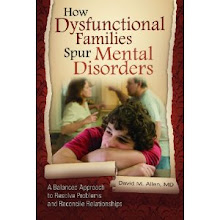Back in the beginning of June 2019 I received an e-mail
from a manager in marketing and communications in NAMI inviting me to write a
blog post for them, as they were planning on featuring articles in August about
personality disorders. I replied that I would be happy to do so. However, I wrote, since I discuss the relationship between family dynamics and personality disorders,
what I write might be offensive to some of NAMI readers. The manager then
suggested to me that I could avoid that and write about what it
means to have a personality disorder and how they are diagnosed.
I agreed to do it, but had a
strong suspicion that they would not like what I would write. I believe
that personality disorders are different from other diagnoses in the DSM
diagnostic manual and that the now-eliminated separate classification (Axis II) should have
been retained. A copy of said blog post
follows this introduction.
I was right. Soon after I
turned in the post, I received an e-mail from higher up on the NAMI food chain,
the Director of Marketing Communications.
She wrote: “…it appears there may be a misunderstanding about the agreed upon blog topic about what it means to have a personality disorder and how they are diagnosed. There are elements in your submission that do not align with NAMI’s position and educational materials about personality disorders. We align with the DSM-5 categorization of personality disorders as mental illness.”
I wrote back thanking them
for the opportunity, but basically saying that I was not going to write a post as
if the definition of
"mental illnesses" in the DSM diagnosis list was not broad, and that it obviously covered some behavioral syndromes that are not brain diseases.
Furthermore, by design,the DSM says nothing about etiology (causes of the disorders).
So why did I sort of know this would happen?
NAMI started out in life as
advocates for the severely and chronically mentally ill – mostly people with
schizophrenia. In the past, they had done some great work in this regard. I know that members were rightfully furious with both
psychoanalysts and especially family systems therapists for blaming what is
essentially a biological brain disease on family dysfunction. Of course, stressful
family environments can make the presentation of any psychiatric or
physical illness worse, but most readers probably know by now that I do not
believe that schizophrenia is caused by family double binds or schizophrenogenic mothers.
Unfortunately, the NAMI membership morphed into those who dislike anyone who would dare suggest that ANY diagnosis in
the DSM just might be created by severe family dysfunction. This position was attractive to the
guilty parents I mention in the masthead of this blog, who do not want to look
at their own family dysfunction, and therefore put a lot of store on phony “biological”
psych disorders like pediatric bipolar disorder and adult ADHD. They joined the
parents of people with actual brain disorders in the advocacy group.
In the post I submitted, I
purposely did not mention adverse childhood experiences or family dysfunction
in making the case that personality disorders (not including Cluster A – see the post) were
behavioral syndromes and not brain diseases. Still, some members of NAMI might suspect that that was the implication of the piece. Unfortunately, there was also a second thing going on at NAMI that, although I
cannot absolutely prove that the two factors led to the rejection of my post. They clearly seem to point
in that direction.
This second process happened around the
time that there was a major change in how NAMI derived the bulk of its funding.
In October of 2009, the
New York Times reported
that Senator Charles Grassley had been looking into how patient advocacy groups
like NAMI were getting a good portion of their funding from big PHarma. He
found that drug makers from 2006
to 2008 contributed nearly $23 million to the alliance, about 75% of its
donations. NAMI has long been criticized for coordinating some of its
lobbying efforts with drug makers and for pushing legislation that also
benefits industry.
Although I was
unable to find more recent reports, there is little reason to think that this
has changed significantly. Of course, if all DSM diagnoses were brain
disorders, then they should be treated with pills, not psychotherapy. This
increases drug sales. NAMI has clearly fallen under their spell.
Here’s the rejected post:
Is a Personality Disorder a Brain Disease?
Personality disorders (PD’s)
are mental
disorders defined as problematic, lasting patterns
of behavior, thinking, and inner experience, exhibited across many social contexts
– but, importantly, not all contexts.
This latter point is seldom appreciated. The patterns are in fact often
dependant on specific types of interactions and situations with certain other
people, and may completely disappear at other times. People who exhibit
symptoms of one of the more severe disorders, borderline personality disorder
(BPD), are well known for creating arguments between doctors and nurses on
hospital wards by acting sweet around one set of them, while acting horribly around
the other set (the infamous staff split).
With the exception of the
Cluster A disorders, described below, they are likely not brain diseases but problems with functioning, especially in
relationships with others, and in my opinion the behavior patterns are learned
responses. Because the behavior can be quite extreme, some people and clinicians
think they simply must be brain
diseases, but the neuroscience does not support that. The fact that the
behaviors appear and disappear depending on social context shows this; real
brain diseases like Alzheimers are not like that. Furthermore, findings on fMRI
studies and heritability
studies, often cited to “prove” that PD’s are brain diseases, are misleading or
fraudulent. Readers can follow the links here to understand how.
Another odd
characteristic of PD’s is that there can be over a hundred different
combinations of traits that all lead to the same
diagnosis. Some traits may even seem contradictory. Narcissistic personality
disorder requires at least 5 of 9 different characteristics— Any 5— or any 6,
7, 8, or all 9. One trait is an excessive need for admiration, but another is
“takes advantage of others.” It is hard to think of a worse way to gain
people’s admiration that to make them feel used!
A patient can also
simultaneously show symptoms of several different PD’s in any possible
combination. One study showed that once someone is diagnosed with BPD, they also
qualify, on average, for 1.6 other PD’s.
Any others.
The traits that make up PD’s
are said to be maladaptive. This
means they cause problems for the intimates of the involved individuals, but
also in the long run are self-destructive or self-defeating for the person with
the disorder. Over the short run, these traits may be used to solve certain
types of interpersonal problems, but the “solution” does not last and prevents the
use of better ways to resolve ongoing problems.
PD’s
were at one time thought by psychiatry to be different from all other psychiatric
disorders. They were placed on a separate “axis” from other disorders - Axis II.
Of course, all human behavior
involves the brain, but as I have argued, PD’s are likely “functional” or behavioral
disorders. For this reason, I was in favor of keeping Axis II. However, because
insurance companies often refused to authorize treatment for them— despite the
fact that they can be highly disabling and require extensive therapy—Axis II
was eliminated. (Psychiatry does not consider causation in describing its diagnoses,
because the true “causes” of almost all of them are not known for certain).
As mentioned, the
personality disorders are subdivided into “clusters” that have common themes.
The first, Cluster A, consists of disorders that are usually a prelude to more
serious brain conditions such as schizophrenia, and probably have little in
common with the PD’s in the other two “clusters.” For this reason, I believe
that they should not have been classified as personality disorders in the first
place, and they will not be discussed further here.
The most serious
personality disorders are seen in Cluster B, the “dramatic” disorders.
Antisocial p.d., the most difficult to treat, is characterized by disrespect
and disregards for the rights of others, often leading to criminal behavior.
They rarely come to therapy voluntarily.
BPD is currently the most
common. I have noticed a marked increase in its prevalence since I was in
training back in the mid 1970’s, which makes me think it is related to ongoing
developments and changes in our culture. It is also seen much less commonly in
traditional cultures. People with BPD often react with strong anger or panic to
seemingly minor slights. This has led some psychiatrists to believe that BPD is
a variation of bipolar disorder, but good evidence says otherwise. People with
BPD are impulsive, self-destructive, and may cut themselves or engage in other
self injurious behaviors. They often worry about being abandoned by loved ones.
A history of overt physical or sexual child abuse is a feature in the
backgrounds of many of them, although certainly not all of them.
Cluster C personality
disorders exhibit highly prevalent anxiety or fearfulness. Those with avoidant PD,
for example, are socially inhibited, feel inadequate, and are hypersensitive to
negative evaluations by others. They constantly worry about what other people
think about them,
Because of their
now-you-see-it, now-you don’t nature, a variety of information must be taken into
account to make an accurate PD diagnosis. Good clinicians specifically ask
about some of the more severe symptoms and behavior in a good
psychiatric diagnostic interview, which includes a complete
history of the patient’s upbringing and relationships over the course of their
lives – things asked about less and less recently. Often it takes more than one
session for the clinician to see the patterns. A patient’s behavior with the
doctor and with the staff also provides clues. Interviews with the patient’s
significant others may reveal important information, although they may at times
be just as misleading as patients sometimes are.








I can recognize the institutional obstacles in your field and am persuaded by your POV on this issue. I am shocked to hear that money drives professional opinion in the world of psychiatry. As an investigative journalist who sees similar institutional bias driven by the profit motive in institutional journalism, I am led to "share your pain." Great article David.
ReplyDelete